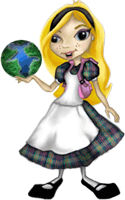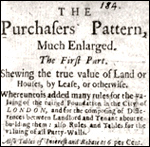 Alice is a programming language developed at Carnegie Mellon that is designed for teaching programming, especially to girls. It uses a drag-and-drop interface and it focuses on creating virtual worlds, animated movies and simple games that can be exported to the web. They have just recieved support from Electronic Arts to use The Sims content (characters) to enahce the sophistication of the resulting animations. The development of Alice is driven by research into teaching programming.
Alice is a programming language developed at Carnegie Mellon that is designed for teaching programming, especially to girls. It uses a drag-and-drop interface and it focuses on creating virtual worlds, animated movies and simple games that can be exported to the web. They have just recieved support from Electronic Arts to use The Sims content (characters) to enahce the sophistication of the resulting animations. The development of Alice is driven by research into teaching programming.
Category: Programming
Interest in CS
Computing Research News has an analysis of survey results from the Highter Education Research Institute at UCLA showing the drop of Computer Science majors.
One thing that is interesting is that this isn’t the first time interest has dropped. It looks like there was a spike of interest in the early 80s that then dropped off to then start spiking again in late 90s.
See also my previous post on this at Dropping Enrollments in Computer Science.
Pattern Books: the history of patterns

How “Pattern Books” Fueled England’s First Speculative Real Estate Market by William Baer in the Harvard Business School’s Working Knowledge (Feb. 17, 2003) provides an interesting peek into the recurring idea of patterns as an alternative to rules or theories.
The term “pattern books” was used generically for books covering a variety of specialized topics that were sold to the trades and the general public. These became quite popular in the seventeenth century and on into the eighteenth, and were part of a rapidly growing publishing industry. “Writings on trade, credit, agricultural improvements, and employment schemes” are examples of some economic and commercial topics covered by pattern books.
This link came from the History Of Patterns in the Portland Pattern Repository which is one of the major foci of the WikiWikiWeb which is arguably the first wiki.
The Dave Orme authored wiki page traces the application of pattern design to software design to 1987 when at OOPSLA 87 they reported on a project for Tektronix where they applied Alexander’s “pattern stuff they’d been studying.”
Paul Graham: Hackers and Painters
Hackers and Painters by Paul Graham is a readable essay about hacking and how it is not computer science, but is akin to painting or writing. He concludes with:
Over and over we see the same pattern. A new medium appears, and people are so excited about it that they explore most of its possibilities in the first couple generations. Hacking seems to be in this phase now.
Painting was not, in Leonardo’s time, as cool as his work helped make it. How cool hacking turns out to be will depend on what we can do with this new medium.
Embedded in the essay is an idea about fame and open source hacking that needs some thought. My sense is that hacking is in the age of genius, while the arts Graham gives as examples were developed during an age where individual genius was not recognized as it is now. Hackers essentially want the recognition they think artists get for open source work even though our idea of genius is a product of a history of Western art culture. What if we reversed the theory and imagined computing culture, that downplays individual genius relative to other arts, as providing a paradigm back to the arts where the genius artist is no longer the norm?
This link came from Matt Patey.
O’Reilly History of Programming Languages
O’Reilly has a poster on The History of Programming Languages that you can download in PDF form that looks neat. They also have a wiki page
on the subject with some pointers on printing it and stuff.
On the wiki page I found a link to a lighter and web version of a timeline on Computer Languages History (preview).
Futurist Programming
- Structured programming = slow.
- Modular = bloated.
- Extensible = late.
- Reusable = buggy.
- Object-Oriented = slow and bloated and late and buggy.
Imagine Futurist Programming – well Paul Haeberli and Bruce Karsh have and it is the opposite of object-oriented. See The Manifesto of the Futurist Programmers which is based on Boccioni’s The Manifesto of the Futurist Painters. Though not sure, I think they see the irony of a “futurist manifesto” that looks back to the past of futurist manifestos.
See also the Futurist Programming Notes for lots of slogans and stuff like the quote at the beginning. Does anyone know if they have kept this up or is it a joke?
Continue reading Futurist Programming
Classic Texts on Computer Science
Classical Computer Science Texts is a list by Jason Kottke of online classics. As he notes, not one is authored by a woman. I particularly like Teach Yourself Programming in Ten Years which reminds me of my Slow Code manifesto.
Perlingata: Latin Perl
From join-the-dots: Perlingata, a Perl module for writing in Latin. For a paper on it, see Lingua::Romana::Perligata — Perl for the XXIimum Century.
Could languages and linguistics contribute to computer language design?
Continue reading Perlingata: Latin Perl
Learning to Program
Matt Kirschenbaum has an interesting blog item on The Pedagogy of Programming where he is gathering links.
One of the best introductions I have found (Steve Ramsay sent me to it) is How to Think Like a Computer Scientist: Learning with Python which is now “translated” for Java and other languages. Anyone up for a Ruby version?
Hackers and Painters
Embracing the Art of Hacking is a review of a book coming out from O’Reilly called Hackers & Painters. (Thanks to Matt Patey for this reference.)
The similarities and differences between art and programming are hopefully worked out beyond the platitude that “programming is an art.” Art is much more than an “art” in the sense of something that can’t be reduced to rules. Just about everything is a small-a art from cooking to dishwashing. To argue that programming is an Art one would have to look at the practices of training, production and consumption. While I doubt the cultures are that similar at the moment, I expect that programming jobs in North America are going to be increasingly in the entertainment area (from games to special effects) and thus programming as a practice will expand our configurations of the arts.